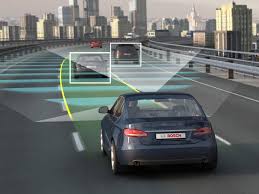
When Mobileye set out to design a safety concept for autonomous vehicles (AVs), we first had to examine the concepts and mechanisms that humans use to maintain road safety. We needed a framework fully compliant with the human road safety system so that AVs could share the same roads. We also needed something demonstrably safer, by design, for society to accept them on the roads.
During development of this system, we discovered the same framework that solves this challenge for AVs is also capable of dramatically improving the safety of the road today via advanced driver assistance systems (ADAS). The solution digitizes the mostly informal, hard-to-enforce social contract that governs road safety today. How this works was the subject of my keynote address today at SAE World Congress.
The Gap in Our Traffic Rules
The foundation of the existing road safety system is traffic rules: explicit, unequivocal instructions to the driver, coded through on-road and road-side signs and indicators such as traffic lights, stop signs, lane dividers, etc.
More: Autonomous Driving at Intel
Still, traffic rules are an under-defined system. Even if all agents rigorously follow them there is still a risk of road accidents. This is because the alternative – to over-define with traffic lights at every junction (no roundabouts) and by making every lane line always solid – would be costly and degrade traffic flow to impractical levels.
Dashed lane lines and yield signs allow for more efficiency, but also leave points of potential conflict in which road users must negotiate with one another (for example, when changing lanes or at a four-way stop). Had these negotiations been left completely unregulated, the outcomes would be a wild function of the different agents’ time-utility and risk-averseness.
This is where the social contract comes in.
The social contract governing careful driving is meant to compensate for the safety gap left by the fact that the traffic rules are under-determined. It minimizes the occurrence of time-critical conflicts and regulates negotiations between road users by directing agents to keep a safe distance from the car ahead, to proceed with caution when visibility is compromised, to give up the right of way if others claim it, and so on. It is a social contract in the sense that we all uphold this unspoken set of rules because we are all better off if we do.
The social contract supersedes traffic rules and can therefore remedy the consequences of traffic rule violations. For example, the social contract would allow an agent to cross a solid lane line if a vehicle in the opposite lane has crossed it right in front him (as long as it does not lead to a different social contract violation).
Despite its critical role in the human road safety system, the social contract for cautious driving has shortcomings. It is broad, without specific definitions of what is safe or appropriate, leaving the correct application up to real-time human judgments. Hence, a lapse of judgment is a leading cause of accidents. The social contract is also nearly impossible to enforce, since detecting a violation requires detailed analysis of a traffic situation.
Digitizing the Social Contract for AVs
Humans must interpret this implicit, non-metric system as they go. But for AVs – which are necessarily explicit and quantitative in their decision-making – we need a more accessible interpretation of this contract. This is the exact premise of Mobileye’s Responsibility-Sensitive Safety (RSS) framework a digital interpretation of the social contract that is explicit, concise, (para)metric, efficiently applicable in real-time and retrospectively traceable.
RSS has several additional contributions critical to road safety. First, it is a formally proven contract, meaning that it is mathematically proven that if all agents implement RSS the vehicle will not cause an accident resulting from a decision-making process, assuming all other vehicle-relevant factors function appropriately. Second, by being completely explicit and quantitative, it aids investigators after an accident regarding different agents’ compliance with the digital social contract.
From Humans to AVs and Back
What started with the AV’s duty to comprehend the human road safety system evolved into an undeniable opportunity to dramatically improve it.
With a safety model that is fully measurable, interpretable and enforceable, we wondered: Why wait for AVs to experience the life-saving benefits of this new reality? Let’s find a way to allow human drivers to benefit from RSS – the digital version of the social contract.
To that aim, we have designed the Vision Zero driver-assistance system, which is purpose-built to meet mass-market deployment and economics. This system uses preventive techniques to help humans avoid emergency responses. It leverages a set of surround cameras and harnesses the RSS framework to provide preventive micro-interventions in accordance with principles of cautious driving. It further benefits from lean, crowd-sourced foresight of upcoming negotiation points and insights to dynamic road-usage patterns and road-network safety vulnerabilities.
This is a very different approach to the current Vision Zero tactics that focus on “road diets” being adopted by cities all over the world. This movement has chosen to deepen the traffic rules with static and pre-set rules like speed limits, speed bumps and physical barriers. These road restrictions are making traffic rules more invasive, and society is paying a high price in efficiency with questionable outcomes
Digitizing the social contract will help make our roads safer, with huge upside potential for traffic flow. With proper regulatory endorsement, these digitized principles of cautious driving may ultimately become a formal, enforceable and binding contract, thereby mitigating the weaknesses in the informal social contract today.
The RSS framework is the digital solution for the social contract that tackles these inherent shortcomings. It also avoids the restrictions of road diets. While RSS was originally envisioned for AVs, we can apply it to ADAS solutions now with immediate impact. This is what I believe is the next revolution in ADAS. It’s a very human concept come full circle.
Erez Dagan is the executive vice president for Products and Strategy at Mobileye and a vice president at Intel Corporation.
About Intel
Intel (NASDAQ: INTC), a leader in the semiconductor industry, is shaping the data-centric future with computing and communications technology that is the foundation of the world’s innovations. The company’s engineering expertise is helping address the world’s greatest challenges as well as helping secure, power and connect billions of devices and the infrastructure of the smart, connected world – from the cloud to the network to the edge and everything in between. Find more information about Intel at newsroom.intel.com














More Stories
Celanese Materials Shine in Multiple Category Winners at 2024 SPE Automotive Innovation Awards
New future-ready single-slot PXIe controller for high-performance T&M applications from Pickering Interfaces
US Army Awards ANELLO Photonics Contract Phase II SBIR Topic “xTech Search 7 SBIR Finalist Open Topic Competition”